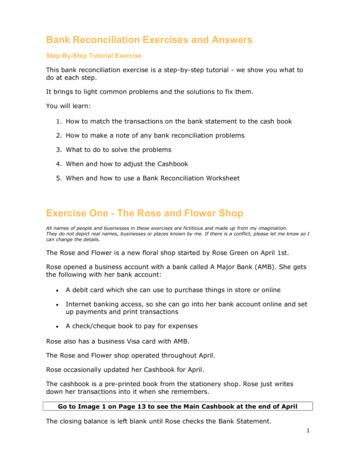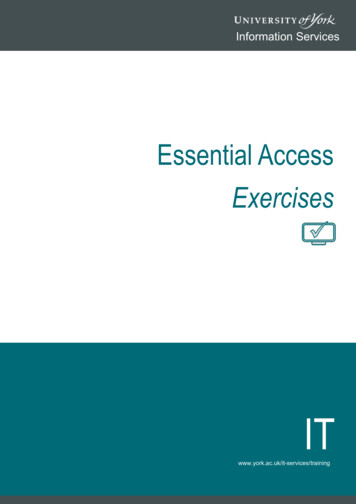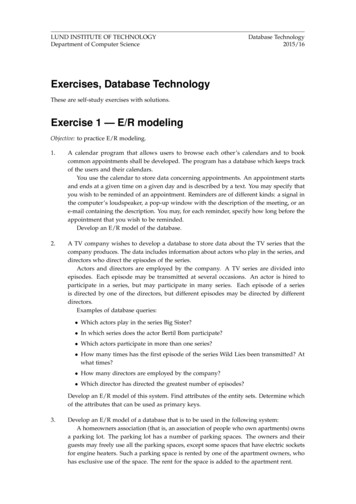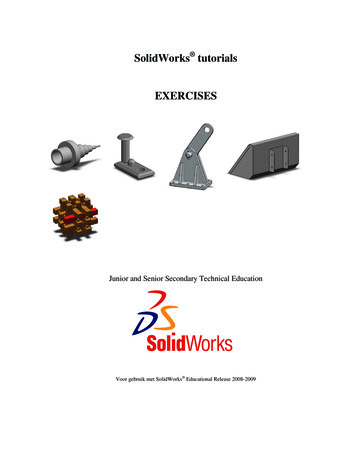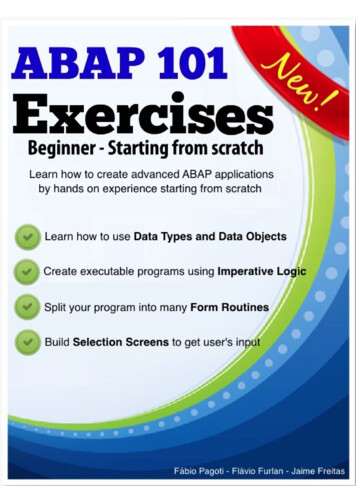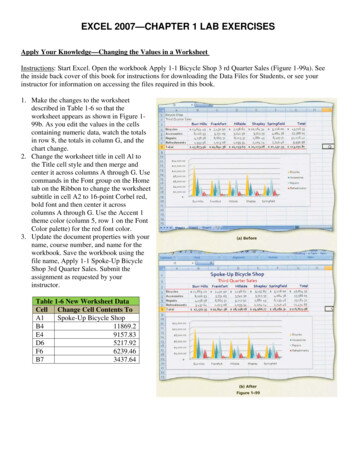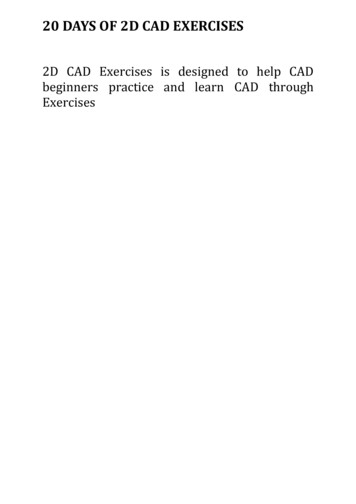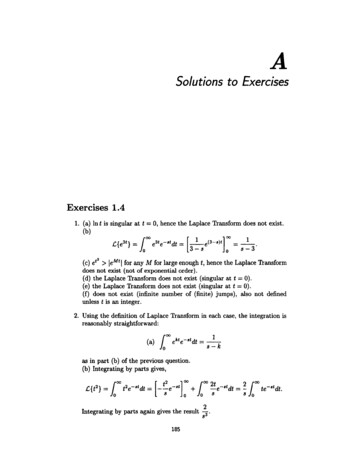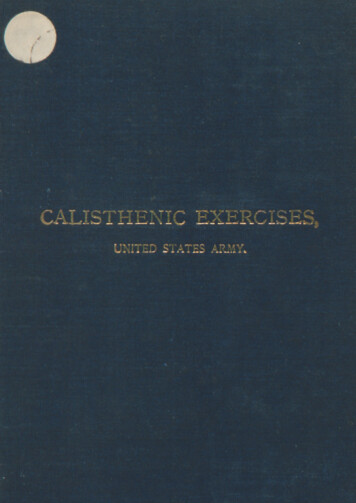
Transcription
3thzi::cUNITED STATESi-ss
This volume, prepared underthe supervision ofand published by the War Department, is theproperty of the United States and by directhe Secretary oi Warforo/icialis'deas3sites withugaSection 74 v: f the act of Congress approvedJanuary 12, 1895, provides as follows:“Government publications furnished to judicial andexecutive officers of the United States for their officialuse shall not become the property of theseofficers, buton the expiration of their official term shall be by themdelivered to their successors in office, and all Govern-ment publications delivered to designated depositoriesorothercharge.”libraries shall be for public use -without
MANUALOFCALISTHENIC EXERCISES,BYAUTHORITYOFTHE WAR DEPARTMENT.WASHINGTON:GOVERNMENT PRINTING OFFICE.1892.
WarDepartment,Washington, I). G., December 4,1891.This Manual of Calisthenic Exercise, prepared by Mr. Herman J.Koehler, master of the sword at the MilitaryAcademy, is publishedfor the information of all concerned. Any calisthenic instructionof enlisted men that may be carried on shouldbe in accordancewiththe provisions of this system.Redpieed Pboctob,Secretaryof War.
PREFACE.The system of calisthenic exercises contained in thiswork is substantially the method devised by Mr. Herman J. Koehler, Swordmaster at the United StatesMilitary Academy, and used in the instruction of cadetssince the introduction of the present system of physicaltraining. Some months since, the Superintendent ofthe Academy, Col. John M. Wilson, Corps of Engineers,perceiving the “wonderful effect upon the carriage andbearing of the younger cadets of the calisthenic exercises as developed by Mr. Koehler,” suggested to him thepropriety of preparing and publishing his system for theuse of the Army and Militia of the United States, andto this end Col. Wilson had photographs taken, showingby figures the positions described in the text. After preparing his manuscript, Mr. Koehler very courteouslytendered it to the Adjutant-General of the Army for theuse of the troops, and the same having been reviewedby a board of officers, in order that the system might beadapted to the new drill regulations, the honorable theSecretary of War directed that all calisthenic instruction for enlisted men should be in accordance with Mr.Koehler's system.The system herein prescribed includes merely thefundamental exercises, combinations having been purposely avoided, but they will suggest themselves in infinite variety in cases where time and occasion permit.It is intended to be preliminary to all other forms ofgymnastics, and supplementary to the setting up exercises prescribed by the drill regulations of the severalarms of the service. They should be thoroughly learnedbefore the squad is advanced to the use of special gymnastic apparatus, as a preparation for such more violentV
VIPREFACE.exercises. The plates which illustrate the work weremade from photographs taken at West Point, the detailed motions of many of the calisthenic exercises havingbeen illustrated by Lieut. George H. Cameron, SeventhCavalry. In its work the board of officers was ablyassisted by Lieut. Peter E. Traub, First Cavalry.
CONTENTS.Page.Order of the Secretary of WarmvPrefaceAdvice to instructors15Commands7Spec ial trainingExercises:Starting positionsArmWrist and fingers,NeckShoulderTrunkLegLower legFoot and toesStraddle position-.1.Leaning rest1LungingGuard positionGuard-step positionHoppingLeapingWalking and marching.StepsDouble timingDouble-timing 748505253
CALISTHEXIC EXERCISES.ADVICE TO INSTRUCTORS.Only those who are masters of this system of calisthenics should undertake to act as instructors.The drill should be made as attractive as possible, andthis can be best accomplished by employing the mind aswell as the body. The movements should be as variedas possible, thus offering the men constantly something new to make them keep their minds on their work.A movement many times repeated presents no attraction; and is executed in a purely mechanical manner,which should always be discountenanced.The exercises should be vigorously executed; and toproperly discipline the muscles, which is one of the manyvaluable features of this method, the greatest accuracyand precision should at all times be insisted on.Short and frequent drills should be given in preferenceto long ones, which are liable to exhaust all concerned,and exhaustion means injury. All movements should becarefully explained, and, if necessary, illustrated by theinstructor.The lesson should begin with the less violent exercises,gradually working up to those that are more so, thengradually working back to the simpler ones, so that themen at the close of the drill will be in as nearly a normalcondition as possible.When one portion of the body is being exercised, careshould be taken that the other parts remain quiet as faras the conformation of the body will allow. The menmust learn to exercise any one portion of the body byitself.The movements of an exercise are executed by command; the portion of the command corresponding to
2CALISTHENIC EXERCISES.that movement which is to be accented, that is, executedwith most vigor, should be emphasized.Judgment must be used in giving commands, for rarelyis the cadence of two exercises alike, and commandsshould indicate not only the cadence of the exercise, butalso the rapidity of execution; for instance:All or nearly all of the movements in the arm exercises are short and quick; hence the commands shouldbe given in a brief tone, following one another in quicksuccession.Again, the movements in the leg and foot exercisescan not be executed as quickly as in the arm exercises,therefore, the commands should be slightly drawn outand should follow one another more slowly.Finally, in the trunk exercises, owing to the deliberateness of execution, the commands should be considerably drawn out and should follow one another in slowsuccession.Instructors should never lose sight of the fact that theyare dealing with and understand the human body; theyshould allow frequent rests, and take into considerationthe condition of the men and their surroundings, thetime of day, etc.; they should at all times encourage andurge the men to improve in their work; by so doing,they will accomplish great good; by neglecting thesefacts, they may work irreparable harm.DRESS.Flannel is the best material to wear next the body ingymnastic exercises, as it absorbs the perspiration,protects the body against drafts, and, in a mild manner, excites the skin. The shirt should be made likean ordinary tourist’s shirt, with collar cut low. Thetrousers should be loose about the legs and held in position by an elastic belt. A tight belt or tight clothingof any kind is positively injurious.Shoes when wornindoors should be made of a light, pliable material,such as canvas or leather, with a light leather heellesssole. For outdoor drills a regulation tennis shoe is best.
ADVICE TO INSTRUCTORS.3HYGIENE.Everything in connection with physical culture shouldbe such that the men look forward to calisthenics andgymnastics with pleasure, not with dread, for the mindexerts more influence over the human body than all thegymnastic paraphernalia that was ever invented.Exercise should be carried on as much as possible ‘inthe open air; at all times in pure, dry air.Only those men whom the post surgeon declares to bephysically qualified and sure to be benefited therebyshould be put through a course of physical training.The old, the rheumatic, and those who require physicalexercise as a therapeutic agent have no business in agymnasium.Never exercise the body to the point of exhaustion.If you pant, feel faint or tired, or experience pain, stopat once, for it is nature’s way of saying too much.”By constant practice learn to breathe slowly throughthe nose during all exercise, especially running.“A fundamental condition of exercise is unimpededrespiration.” Proper breathing should always be insisted upon; “holding the breath” or breathing onlywhen it can no longer be held is as injurious as lightclothing. Every exercise should be accompanied by anunimpeded and if possible by an uninterrupted act ofrespiration, the inspiration and expiration of whichdepend to a great extent upon the nature of the exercise.Inhalation should always accompany that part of ourexercise which tends to elevate and distend the thorax—as raising arms over head latterly, for instance; whilethat part of an exercise which exerts a pressure againstthe walls of the chest should be accompanied by exhalation, and lowering arms latterly from shoulders or overhead, for example.If after exercising the breathing becomes labored anddistressful, it is an unmistakable sign that the work has“
4CALISTHENIG EXERCISES.been excessive. Such excessiveness is not infrequentlythe cause of serious injury to the heart or lungs, of toboth. In cases where exercise produces palpitation,labored respiration, etc., it is advisable to recommendabsolute rest, or to order the execution of such exercisesas will relieve the oppressed and overtaxed organ. Legexercises slowly extended will afford great relief. «Bydrawing the blood from the upper to the lower extremities they equalize the circulation, thereby lessening theheart’s action and quieting the respiration. For suchexercises see Leg Exercises.Never exercise immediately after a meal; digestion ismore important at this time than extraneous exercise.Never eat or drink immediately after exercise; allowthe body to recover its normal condition first, and themost beneficial results will follow.If necessary, pure water, not too cold, may be taken insmall quantities, but the exercise should be continued,especially if in a state of perspiration.Never, if at all possible, allow the underclothing to dryon the body.Muscular action produces an unusual amount of bodilyheat; this should be lost gradually, otherwise the bodywill be chilled; hence, after exercise, never take off clothing, but, on the contrary, wear some wrap in addition.In like manner, be well wrapped on leaving the gymnasium.Cold baths, especially when the body is heated, as isthe case after exercising violently, should be discouraged.In individual instances such baths may appear apparentlybeneficial, or at least not injurious; in the majority ofcases, however, they can not be used with impunity.Tepid baths are recommended. When impossible tobathe, the flannels worn while exercising should bestripped off, the body sponged with tepid water, andthen rubbed thoroughly with coarse towels. After sucha sponge bath the body should be clothed in clean, warmclothing.
5COMMANDS.COMMANDS.There are two kinds of commandsThe preparatory indicates the movement to he executed.The command of execution causes the execution.In the command: 1. Arms forward, 2. Raise, the wordsarms forward constitute the preparatory command, andraise, the command of execution. Preparatory commandsare printed in italics, and those of execution in Capitals.The tone of command is animated, distinct, and of aloudness proportioned to the number of men under instruction.Each preparatory command is pronouncedin an ascending tone of voice, but in such a manner thatthe command of execution, always in a firm and brieftone, may be more energetic and elevated.:THE POSITION OF ATTENTION.This is the position that an unarmed, dismounted soldier assumes when in ranks. During the calisthenic exercises, it is assumed whenever the command attention,or halt, is given by the instructor.Having allowed his men to rest, the instructor commands 1. Squad, 2. Attention.The words class, section, or company may be substituted for the word squad.At attention, the men will quickly assume and retainthe following position;Heels on same line and as near each other as the conformation of the man permits.Feet turned out equally and forming with each otheran angle of about 60cKnees straight, and, if possible, without stiffness,closed.The body erect on the hips, inclining a little forward.:.
6CALISTHBNIG EXERCISES.Shoulders well back and square, thus throwing - outand slightly raising the chest.Arms and hands hanging naturally; elbows near thebody; backs of hands turned outward; little fingers opposite,the seams of the trousers.Head erect and square to the front; chin slightlydrawn in, without constraint; eyes straight to the front.FORMATION.The men form in a single rank, tallest man on theright.The instructor commands; 1. Count , 2. Fours.Beginning on the right, the men count one, two, three,four, and so on, to the left.The instructor then commands : 1. Fours right (or left),2. March, 3. Squad, 4. Halt.At the command march , each set of fours wheels 90 tothe right on a fixed pivot, halting at halt.To take intervals, he then commands: 1. To the right(or left) take intervals 2. March.At the command march , the man on the left of eachfour stands fast; the other men face to the right andstep off, each man halting faced to the front, when hehas the proper interval of two paces.To prove intervals, he then commands : 1. Prove 2. In,,tervals.At the command intervals the men raise their armslaterally to the horizontal position, giving way in easethey touch their neighbors’ hands; they then resume theattention.To rest the men, the instructor commands Fall out,or Rest, or At Ease.At the command fall out the men may leave the ranks,but will remain in the immediate vicinity; at the command fall in they resume their former places.At the command rest, the men keep one heel in place,but are not required to preserve silence or immobility.,:,,
COMMANDS.7At the command at ease, the men keep one heel inplace and preserve silence, but not immobility.To resume the attention: 1. Squad, 2. Attention.To assemble, the instructor commands; 1. To the right(or left ) assemble, 2. March.At the command march, the man on the right of eachfour stands fast, the other m
Thisvolume,preparedunderthesupervisionof and published bytheWar Department,isthe property of the United States and by direc- theSecretaryoiWar is'deas3siteswith for o/icial uga Section 74v: f the act ofCongress approved January 12, 1895,provides as follows: “Governmentpublications furnished tojudicialand executive officers of the United States fortheir official use shall notbecome the .
